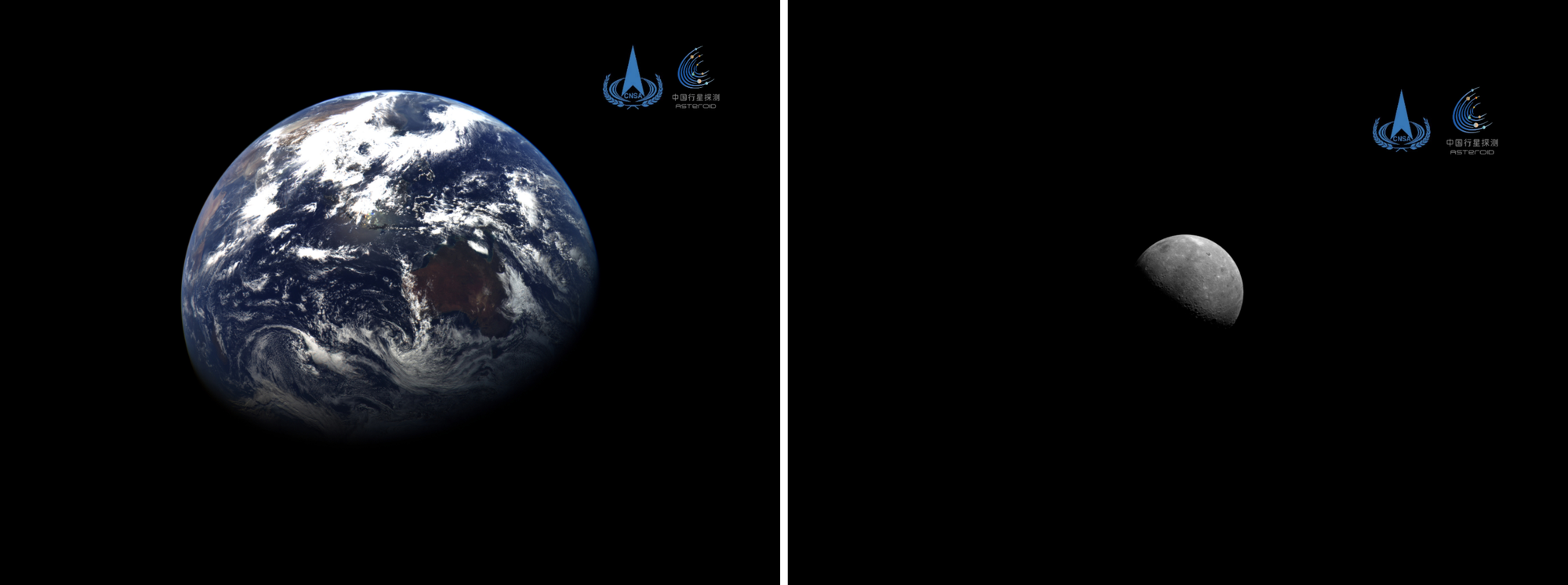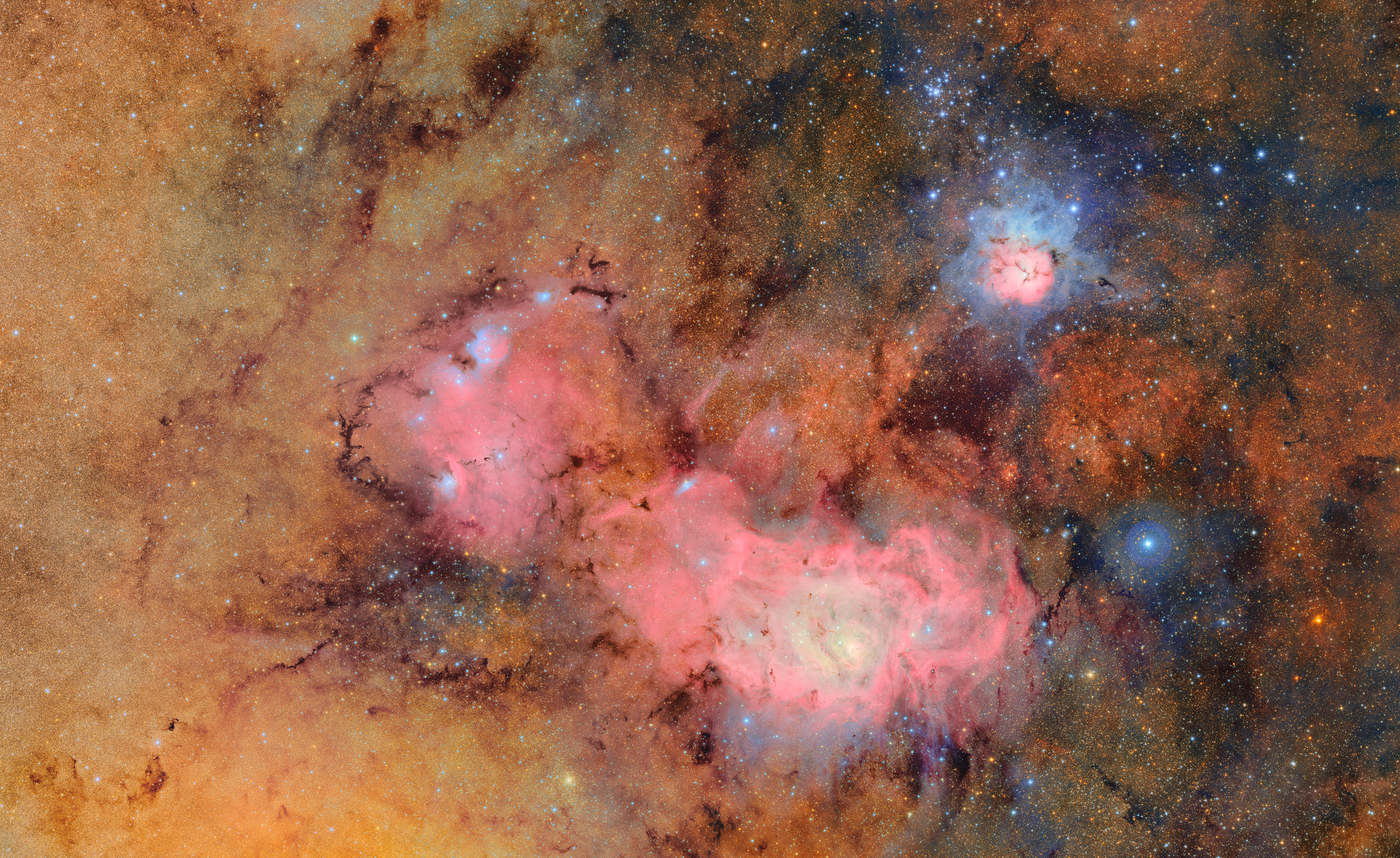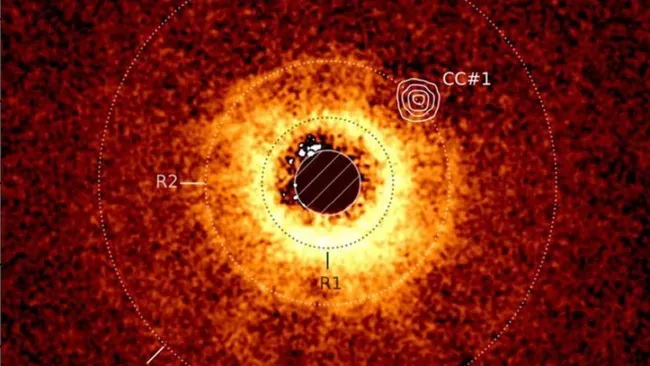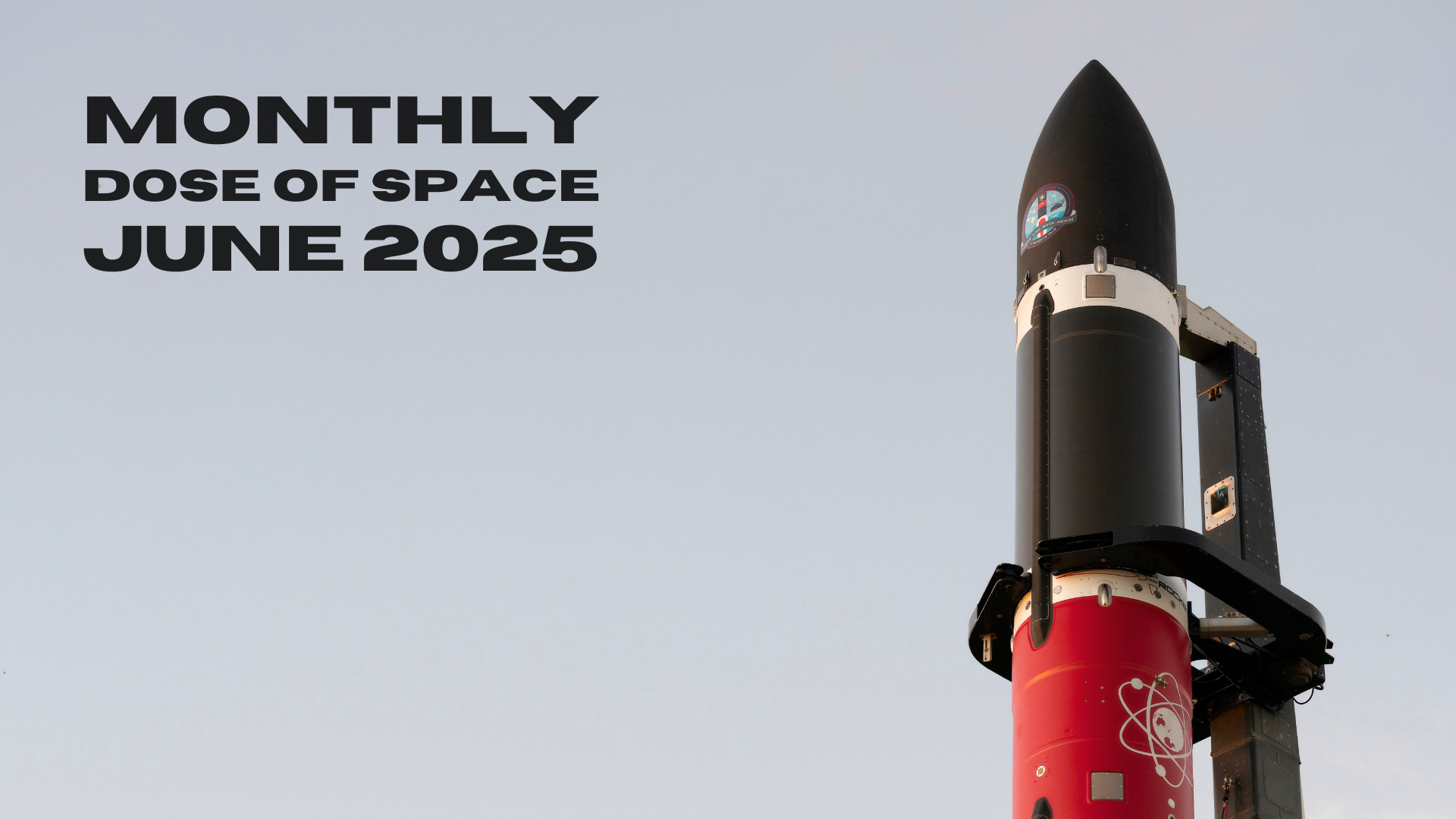Table of Contents
Welcome to our twenty-first Monthly Dose of Space! In this monthly newsletter, we bring you major news from the past month. The end of June brings us to the midpoint of the year, so let's jump into the past month!
News of the Month
News during June has seen new discoveries and images of the universe beyond our solar system, new commercial launch systems progressing through key tests, the latest in a series of collaborative satellites, and a space-related budget increase?
Tianwen-2 photographs the Earth & Moon

The Tianwen-2 asteroid sample return mission is currently over 12 million kilometers away from Earth as it heads out to asteroid 2016HO3/469219 Kamoʻoalewa, with a planned arrival in the summer of 2026, where it will gather between 200 and 1,000 grams of samples. Around 2029, those samples will be returned to Earth during a flyby.
Recently, in the last hours of the month, the China National Space Administration shared two images captured by the spacecraft’s Asteroid Narrow Angle Camera. Those images were of the Earth and Moon, seen from a distance of 590,000 kilometers as the probe left the Earth-Moon system for interplanetary space.
The new images follow the first one shared from the mission in early June, of the spacecraft's circular solar panel fully unfurled. Further images are likely to come from Tianwen-2 in the future, as the mission is said to be housing deployable cameras that will image the spacecraft from a third-person perspective.

U.S. Space Force eyes 40 billion budget
SpaceNews is reporting that under President Donald Trump's 'One Big, Beautiful Bill', the U.S. Space Force's budget will be increased to 39.9 billion United States Dollars in 2026, a massive increase from its 2025 budget of 28.7 billion.
The 2026 budget would provide the military space branch with 26.1 billion in traditional funding, along with 13.8 billion through a reconciliation package. This major increase in funding is reportedly due to Trump wanting an overall budget of one trillion dollars for the U.S. military.
It is unknown what the Space Force will spend its new billions on, but options include the 'Golden Dome' system, itself unclear in use, or on-orbit military assets. Additionally, the funding provided through a reconciliation package is expected to last ten years.
A potentially massive funding increase for the Space Force comes as NASA is facing dramatic cuts across its scientific and exploration portfolio. It is also becoming rather clear where American priorities in space are.
Brazil, China begin work on Earth resource satellite
Brazil enacted the legal protocols for the sixth China-Brazil Earth Resources Satellite, commonly shortened to CBERS, on June 10th formally authorizing joint development of the spacecraft. Prior legal documents were signed over the last two years.
Work on the satellite will be conducted by the China Academy of Space Technology and Brazil’s Instituto Nacional de Pesquisas Espaciais (National Institute for Space Research). A preliminary design review for the spacecraft was completed by both sides in mid-2024, and in December of the same year, Brazil approved the beginning of spacecraft production.
CBERS-6 is set to use Brazil’s Multi Mission Platform to support necessary spacecraft systems. Instruments planned to be onboard the spacecraft include an X-band synthetic aperture radar, provided by the Chinese side, with an imaging resolution as low as 1 meter, which will enable all-day, any-weather, any-condition imaging of the Earth's surface.
Following satellite development, CBERS-6 will head to a sun-synchronous orbit in 2028. Data collected by the spacecraft is planned to be used for planning, monitoring, and control of deforestation, border surveillance, urban planning, water resources and vegetation monitoring, coastal surveillance, and agricultural support. This data will also be complemented by previous CBERS satellites.
CAS Space performs static fires
It's official! We have completed the first-stage hot fire testing, very successfully, at the dedicated CAS Space engine testing center located in Conghua, Guangzhou.
— CAS Space (@cas_space) June 12, 2025
The test center is currently the sole engine and propulsion system test center in southern China. The complex… pic.twitter.com/7Kknj2sDTi
Kinetica-2's first-stage booster performing its static fire, via CAS Space on Twitter.
CAS Space, one of China's commercial launch companies and operator of the Kinetica series of rockets, fired hardware for both its orbital and suborbital rockets during June.
Beginning on June 11th, CAS Space has fired up one of the first-stage boosters of its Kinetica-2 launch vehicle at the company’s dedicated engine firing center in Conghua, Guangzhou, Guangdong province. The test static fired one Kinetica-2’s first-stage booster equipped with three YF-102 engines burning rocket-grade kerosene and liquid oxygen. For the test, the three engines fired for approximately 169 seconds while generating around 255 tons of thrust.
In its blog post about the static fire, the company stated that the test had:
"[Fully] verified the coordination and matching between the rocket's first-stage pressurization and delivery system and the engine system, as well as the correctness of the system interfaces such as power, structure, avionics, and launch support."
Just over a week later, CAS Space also fired up the engine for its Lihong-2 reusable suborbital tourist vehicle, known as Liqing-1 or Kinecore-1. The test firings saw the engine fired twice, a first firing lasted for 100 seconds while the second lasted for 80 seconds.
We have successfully tested the Kinecore (Liqing) - 1 engine with a 180s hot fire test. The 294 kN (ground thrust) engine will power the Lihong-2 reusable suborbital vehicle.
— CAS Space (@cas_space) June 19, 2025
The engine is developed in-house, featuring a pintle injector mechanism, and is constructed from… pic.twitter.com/hPJMjp9hcH
The Liqing-1 engine during its two test firings, via CAS Space on Twitter.
Liqing-1 burns liquid oxygen and rocket-grade kerosene to generate 30 tons of thrust, via a gas generator cycle with a pintle injector to provide fuel and a regeneratively cooled nozzle. This is said to allow a throttle range between fifty to one hundred percent of the engine’s thrust while starting up to three times. Five Liqing-1 engines are designed to power the company’s Lihong-2 tourism vehicle.
Following those tests, on June 25th the company fired up Kinetica-2's second-stage for two static fires, on the same test stand used for the first-stage booster. The first static fire lasted for around 280 seconds while the second lasted for just 25 seconds.
Both test firings simulated flight conditions and durations while testing the YF-102V engine’s ability to gimbal while producing thrust, around 85 tons. During the test, two start-ups and shut-downs were performed to demonstrate the second-stage mission profile.
Kinetica-2 is currently expected to perform its debut flight from the Jiuquan Satellite Launch Center in September of this year, while Lihong-2 may not fly until around 2026 or 2027. Lessons learned with Lihong-2 may be applied to Kinetica-2 once it is equipped for reusable operation around 2028.
Rubin Observatory shares first images

The U.S. National Science Foundation and the U.S. Department of Energy's Office of Science shared the first images from its Vera C. Rubin Observatory, located in Chile, on June 23rd. The observatory is named after U.S. astronomer Vera C. Rubin, who found conclusive evidence of vast quantities of invisible material known as dark matter.
Utilizing its 8.4-meter telescope, said to be the largest digital camera ever built, the Rubin Observatory revealed new ultra-high-definition images of galaxies, nebulae, and over 2,100 never-before-seen asteroids (found in just ten hours). Luckily, none of these asteroids are expected to pose a threat to Earth.
Speaking on the new observatory, Brian Stone, Acting Director of the National Science Foundation, said:
"[The] Rubin Observatory will capture more information about our Universe than all optical telescopes throughout history combined," – "Through this remarkable scientific facility, we will explore many cosmic mysteries, including the dark matter and dark energy that permeate the Universe."
This bounty of data will help scientists make new discoveries about the Universe and will serve as an become a resource for scientific exploration for years to come.
James Webb finds new exo-planet

Since its launch on Christmas Day, 2021, the James Webb Space Telescope has been a powerful asset to astronomers across the globe. Recently, the powerful eye in the sky found a new exoplanet, dubbed TWA 7b, orbiting around the (relatively) young CE Antilae star, which is just a few million years old.
Besides being Webb's first exoplanet find, TWA 7b is the smallest exoplanet humanity has directly imaged. The planet has a mass 100 times that of Earth or about 0.3 times that of Jupiter. Since the 1999s CE Antilae has been a closely studied star due to its unique "pole" position relative to Earth. Simply put, we see the CE Antilae system from a top-down view, allowing us to see structures we normally cannot.
Launches of the Month
This month saw 26 launches worldwide, continuing a busy year. If you want to know what each launch was we have them all listed below!
June 3rd - Electron for 'Full Stream Ahead'
Rocket Lab launched its Electron rocket from Launch Complex 1B on the Māhia Peninsula, in New Zealand, carrying a single satellite to low Earth orbit for BlackSky Technology. BlackSky's satellite will provide images with a 50-centimeter resolution to customers.
June 3rd - Falcon 9 with Starlink Group 12-19
Twenty-three Starlink satellites were launched atop of a Falcon 9 to low Earth orbit out of Space Launch Complex 40, in Florida. In support of this mission was booster B1077, for its twenty-first flight with a landing on the drone ship 'Just Read The Instructions' downrange.
This was also the 500th launch for SpaceX's family of Falcon rockets, including Falcon 1, Falcon 9, and Falcon Heavy.
June 5th - Falcon 9 with Starlink Group 11-22
Twenty-seven Starlink satellites were sent to low Earth orbit atop of a Falcon 9 flying from Space Launch Complex 4E, in California. Booster B1063 supported this launch for its twenty-sixth flight, with a landing downrange on the drone ship 'Of Course I Still Love You'.
June 5th - Long March 6A with GuoWang Group 04
A Long March 6A launched from Launch Complex 9A at the Taiyuan Satellite Launch Center carrying five satellites into polar orbit for GuoWang's fourth satellite group. With this launch, the GuoWang mega-constellation has 34 satellites in orbit out of a possible 13,000, which will eventually provide worldwide internet services.
June 7th - Falcon 9 with SXM-10
SpaceX launched SiriusXM's SXM-10 satellite to geostationary transfer orbit with a Falcon 9 from Space Launch Complex 40. The SXM-10 satellite will be used to transmit SiriusXM's programming to its listeners' radios.
June 8th - Falcon 9 with Starlink Group 15-8
Twenty-six Starlink satellites were delivered to low Earth orbit by a Falcon 9 flying from Space Launch Complex 4E, in California. Supporting this mission was booster B1088 flying for the seventh time, and landing downrange on the drone ship 'Of Course I Still Love You'.
June 10th - Falcon 9 with Starlink Group 12-24
Falcon 9 lifted off from Space Launch Complex 40, in Florida, carrying twenty-three more Starlink satellites into low Earth orbit. Booster B1083 supported this mission for its twelfth flight, landing on the drone ship 'Just Read The Instructions' downrange.
June 11th - Electron for 'The Mountain God Guards'
Rocket Lab once again flew its Electron rocket from Launch Complex 1A on the Māhia Peninsula, carrying a synthetic aperture radar satellite to low Earth orbit, on behalf of iQPS. The satellite is part of a planned thirty-six satellite constellation that can image a chosen part of the Earth every ten minutes.
June 13th - Falcon 9 with Starlink Group 15-6
Another twenty-six Starlink satellites headed to low Earth orbit atop of a Falcon 9 flying out of Space Launch Complex 4E. Supporting this mission was booster B1081, flying for the fifteenth time with a landing on the drone ship 'Of Course I Still Love You' downrange.
June 13th - Falcon 9 with Starlink Group 12-26
Twenty-three more Starlink satellites rode into low orbit Earth atop of a Falcon 9 from Space Launch Complex 40. Booster B1078 supported this mission for its twenty-first flight, with a landing on the drone ship 'A Shortfall Of Gravitas' downrange.
June 14th - Long March 2D with Zhangheng-1-02
A Long March 2D blasted off from the Jiuquan Satellite Launch Center carrying the Chinese-Italian Zhangheng-1-02, also known as China Seismo-Electromagnetic Satellite 02, to sun-synchronous orbit. The satellite is expected to provide natural disaster monitoring and prediction, as well as space environment monitoring and forecasting.
June 17th - Falcon 9 with Starlink Group 15-9
A Falcon 9 lifted off from Space Launch Complex 4E, in California, carrying twenty-six Starlink satellites into low Earth orbit. Supporting this mission was booster B1093, making its third flight, and landing on the drone ship 'Of Course I Still Love You' downrange.
June 18th - Falcon 9 with Starlink Group 10-18
Another twenty-eight Starlink satellites were sent to low Earth orbit by a Falcon 9 flying from Space Launch Complex 40, in Florida. Booster B1090 supported this mission for its fifth flight, with a downrange landing on the drone ship 'Just Read The Instructions'.
June 19th - Angara-A5 with an unknown payload
An Angara-A5 flew for what is believed to be its first operational flight from the Plesetsk Cosmodrome. The payload atop of the rocket is unknown, possibly a military satellite, but heading toward geostationary orbit.
June 20th - Long March 3B/E with ChinaSat-9C
A Long March 3B/E blasted off from the Xichang Satellite Launch Center, for the rocket's ninth flight of the year, carrying ChinaSat-9C to a geostationary transfer orbit. ChinaSat-9C is planned to replace ChinaSat-9, currently residing over China, along with its radio, television, and communication services.
June 23rd - Falcon 9 with Starlink Group 10-23
A Falcon 9 flew from Space Launch Complex 40, in Florida, carrying twenty-seven Starlink satellites into low Earth orbit. Supporting this mission was booster B1069, performing its twenty-fifth flight, and landing downrange on the drone ship 'A Shortfall Of Gravitas'.
June 23rd - Atlas V with KA-02
United Launch Alliance's Atlas V rocket roared from Space Launch Complex 41, in Florida, carrying the second batch of twenty-seven satellites for Amazon's Kuiper internet-providing mega-constellation into low Earth orbit. With the launch of a second group of satellites, Amazon now has 54 spacecraft in orbit, out of a planned total of 3,236.
June 23rd - Falcon 9 with Transporter-14
SpaceX performed its Transporter-14 rideshare mission, carrying seventy small satellites, with a Falcon 9 flying to sun-synchronous orbit from Space Launch Complex 4E, in California. Booster B1071 supported this mission for its twenty-sixth flight, with a landing on the drone ship 'Of Course I Still Love You' downrange.
June 25th - Falcon 9 with Axiom-4
Axiom Space's Axiom-4 mission departed from Launch Complex 39A, in Florida, atop of a Falcon 9, carrying Peggy Whitson, Shubhanshu Shukla, Sławosz Uznański-Wiśniewski, and Tibor Kapu toward the International Space Station. Crew Dragon 'Grace' is flying for the first time during this mission, while the launch was supported by booster B1094, performing its second flight and landing back at Landing Zone 1 in Cape Canaveral. Details on the mission are available here.
June 25th - Falcon 9 with Starlink Group 10-16
Another twenty-seven Starlink satellites were delivered to low Earth orbit by a Falcon 9 launching from Space Launch Complex 40. Supporting this mission was booster B1080, flying for the twentieth time, and landing on the drone ship 'Just Read The Instructions' downrange.
June 26th - Electron for 'Get The Hawk Outta Here'
Rocket Lab's Electron rocket flew again from Launch Complex 1A, carrying three satellites into low Earth orbit for HawkEye 360. The satellites aim to provide precise mapping of radio frequency emissions worldwide.
June 28th - Falcon 9 with Starlink 10-34
Falcon 9 once again launched twenty-seven Starlink satellites to low Earth orbit from Space Launch Complex 40. Booster B1092, flying for the fifth time, supported this mission, with a landing on the drone ship 'A Shortfall Of Gravitas' downrange.
June 28th - Electron for 'Symphony In The Stars'
Another Electron flew from Launch Complex 1B for a mission to sun-synchronous orbit. The customer for this mission is unknown.
June 28th - H-IIA with GOSAT-GW
Japan's H-IIA rocket blasted off from the Tanegashima Space Center carrying a single payload to sun-synchronous orbit. The satellite riding atop of the rocket was GOSAT-GW (Greenhouse Gases Observing Satellite, Greenhouse gases and Water cycle), which will monitor greenhouse gases in Earth's atmosphere.
This was also the final flight of Japan's H-II series of rockets.
June 28th - Falcon 9 with Starlink Group 15-7
Twenty-six more Starlink satellites were delivered to low Earth orbit from Space Launch Complex 4E by a Falcon 9. Booster B1088 supported this mission for its eighth flight, landing downrange on the drone ship 'Of Course I Still Love You'.
June 29th - New Shepard with NS-33
Blue Origin performed New Shepard's suborbital NS-33 mission from its West Texas launch site, carrying Allie Kuehner, Carl Kuehner, Leland Larson, Freddie Rescigno, Owolabi Salis, and James Sitkin above the Kármán line. The vehicles used during the mission were booster NS5, flying for the fourth time, and capsule RSS Kármán Line, making its third flight.
Launches to look out for in July!
July will continue a busy year for worldwide launches. Listed below are all of the launches expected or likely to happen next month, launches on the 1st of July may have already occurred due to when this newsletter is published.
July 1st - Falcon 9 with MTG-S1
A Falcon 9 is expected to launch the MTG-S1 spacecraft from Launch Complex 39A to a geostationary transfer orbit.
July 2nd - Falcon 9 with Starlink Group 10-25
Twenty-seven more Starlink satellites are planned to head to low Earth orbit atop of a Falcon 9 from Space Launch Complex 40.
July 2nd - Eris for its debut flight
Gilmour Space is planning to perform the debut flight of its Eris rocket from the Bowen Orbital Spaceport, in Australia.
July 3rd - Long March 4B with a to-be-announced payload
A Long March 4B may lift off from the Xichang Satellite Launch Center, heading for low Earth orbit.
July 3rd - Soyuz 2.1a with Progress MS-31
A Soyuz 2.1a is preparing to launch from the Baikonur Cosmodrome with the Progress MS-31 spacecraft bound for the International Space Station.
July 16th - GLSV Mk II with NISAR
The Indian Space Research Organisation is expecting to launch its joint spacecraft with NASA (NASA-ISRO Synthetic Aperture Radar, or NISAR) to sun-synchronous orbit atop of a GSLV Mk II rocket from the Satish Dhawan Space Center.
July 25th - Soyuz 2.1b with two Ionosfera-M satellites
Two Ionosfera-M ionospheric and magnetospheric research satellites are planned to launch to sun-synchronous orbit atop of a Soyuz 2.1b from the Vostochny Cosmodrome.
July 26th - Vega-C with CO3D & MicroCarb
A Vega-C is preparing to launch from the Guiana Space Centre carrying two satellites to sun-synchronous orbit, CO3D for Earth observations and MicroCarb to map sources and sinks of carbon dioxide.
July 31st - Falcon 9 with Crew-11
NASA's Crew-11 mission, with astronauts Zena Cardman and Mike Fincke, as well as JAXA's Kimiya Yui and Roscosmos' Oleg Platanov, to the International Space Station is expected to launch atop of a Falcon 9 from Launch Complex 39A.







